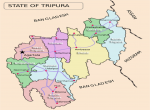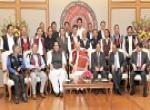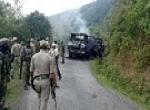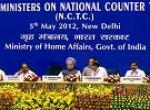Among other things, one of the major aspects that have come out of the recent communal violence in Bodo areas of Assam is illegal migration. According to the Group of Ministers Report on National Security, illegal migration
has generated a host of destabilizing political, social, economic, ethnic and communal tensions. Politically, the Bangladeshi migrants are in a position to influence the results of the elections in a large number of constituencies in the North East (about 32% of the constituencies in Assam). Economically, increased pressure on land, resulting in depletion of forest wealth, undercutting of wages of unskilled jobs, forcible occupation of Government land by the migrants and a host of other such issues, generate a ripple effect in the entire North East. 1
Illegal migration mainly takes place in the eastern and north-eastern parts of the country from neighbouring Bangladesh.
Bangladeshis have been moving out of their country due to economic, political and social reasons. There is a serious crisis of ‘lebensraum’ (living space) in Bangladesh due to alarming population growth rate without proportionate availability of land. This is going to worsen further in the future with the impact of climate change and natural disasters. As per 2011 estimates, the population density of Bangladesh is 964 per sq km, one of the highest in the world. Only Singapore and small city-states like Bahrain or the Vatican have higher figures.2 And, this is expected to increase further in the coming years.
As observed by the Group of Ministers Report, illegal immigration from Bangladesh has led to demographic upheaval and generated serious communal, political, social and economic tensions and conflicts in several areas of the northeast of India. The most affected states are West Bengal, Assam, Megalaya, Nagaland, Bihar, and Tripura, although migrants “have spread to far off states like Tamil Nadu, Maharashtra, Gujarat, Rajasthan and Delhi.” 3 Although the exact figure is not known, it is estimated that there are about 15-20 million Bangladeshis staying illegally in India. 4 The illegal migration of Bangladeshis in fact triggered the agitation in Assam by All Assam Students Union (AASU) in 1979-85. Despite the Assam Accord of 1985 5, the issue remains unresolved to this day and the “silent demographic invasion” persists. Due to vote-bank politics, the motivation to block illegal migrants from Bangladesh is absent. The gravity and scope of threats arising out of illegal migration was highlighted by the then Governor of Assam, Lt Gen S. K. Sinha in his report. Inter alia, he points out,
This silent and invidious demographic invasion of Assam may result in the loss of the geo-strategically vital districts of Lower Assam. The influx of these illegal migrants is turning these districts into a Muslim majority region. It will then only be a matter of time when a demand for their merger with Bangladesh may be made. The rapid growth of international Islamic fundamentalism may provide the driving force for this demand. In this context, it is pertinent that Bangladesh has long discarded secularism and has chosen to become an Islamic State. Loss of Lower Assam will sever the entire land mass of the North East, from the rest of India and the rich natural resources of that region will be lost to the Nation.6,
This applies to other states of the north-east, especially those that share borders with Bangladesh like Tripura and Meghalaya. In Tripura, the migrants have reduced the locals to a minority leading to rise of insurgent groups like All Tripura Tiger Force (ATTF). Bangladeshi migrants have even spread to far off states in the region like Arunachal Pradesh, and other parts of India and are seen as potential threat bearers. Some of these migrants give shelter to Bangladeshi militant groups like HuJI (B) and are very amenable to ISI activities. The Supreme Court, in its 114-page judgment, in July 2005 observed that “The presence of such a large number of illegal migrants from Bangladesh, which runs into millions, is in fact an ‘aggression’ on the State of Assam and has also contributed significantly in causing serious ‘internal disturbances’ in the shape of insurgency of alarming proportion making the life of the people of Assam wholly insecure and the panic generated thereby has created a fear psychosis.”7
Despite the enormity of the issue, the response has been grossly inadequate. The entire stretch of 4,096-km India-Bangladesh border is heavily populated, making monitoring extremely difficult. Fencing has to a large extent been acting as an obstacle, but only 2,760.12 km have been fenced so far.8 The remaining stretch should be fenced at the earliest, complimented with floodlights and hi-tech surveillance devices. Most importantly, existing border has to be demarcated at the earliest to make them free of ‘enclaves’ and ‘adverse positions’; much of activities take place in these undemarcated areas. Although the Border Security Force (BSF), in charge of policing the border, has been doing its job creditably, the force levels are not sufficient to monitor the long and difficult border. Apart from raising new battalions, it is important not to divert the BSF for duties other than border management. They also have to be equipped legally to handle situations at borders that include not only illegal migration, but also smuggling, drug-trafficking, counterfeits, and militant movements.
Apart from creating physical hurdles, it is also important to discourage illegal migrants through suitable deterrent legislation. Till recently, illegal migrants in Assam were handled by Illegal Migration (Determination by Tribunals) Act, 1983, that was held as unconstitutional by the Supreme Court in 2005 as it was “coming to the advantage of such illegal migrants as any proceedings initiated against them almost entirely ends in their favour, enables them to have a document having official sanctity to the effect that they are not illegal migrants.”9 An exclusive refugee/migration law is long pending. It is also vital to issue multi-purpose identity cards, at least to curb further illegal migration. At some pockets of Indo-Bangladesh border, issue of temporary work permits can be considered so that Bangladeshis can come, work and go back. At the macro level, India should help in the overall economic development and prosperity of Bangladesh so that its citizens need not to go elsewhere for their livelihood.
Endnotes
- See Group of Ministers Report on Reforming the National Security System, Chapter II, p. 6, para 2.35.
- For full details, see Bangladesh Bureau of Statistics, Ministry of Planning, Government of the People’s Republic of Bangladesh, “Population and Housing Census 2011,” p. 8, para 2.4.
- Group of Ministers Report on Reforming the National Security System, Para 2.35 of the.
- Ibid, p. 60, para 5.8 (h).
- Full text of the Agreement is available at http://aasc.nic.in/Acts%20and%20Rules%20(GOA)/Implementation%20of%20Assam%20Accord%20Deptt/Assam%20Accord.pdf Interestingly, there is a separate ‘The Implementation of Assam Accord Department’ in the Government of Assam that acts as “a Nodal Department for implementation of the Assam Accord and to monitor the implementation of various clauses of the Assam Accord by different Departments of the State Government.” For details see http://assamgovt.nic.in/departments/accord_dept.asp.
- See Chapter II, Para 24 of the Report. D. O. No. GSAG.3/98, dated 08 November 1998, full text of the report is available at http://www.satp.org/satporgtp/countries/india/states/assam/documents/papers/illegal_migration_in_assam.htm, accessed on 01 August 2012.
- Sarbananda Sonowal v. Union of India (UOI) and Another, No. 131 of 2000, India: Supreme Court, 12 July 2005, para no. 39, available at http://www.unhcr.org/refworld/docid/46b1c2eb2.html , accessed 4 August 2012.
- Ministry of Home Affairs, Government of India, Annual Report 2011-12, pp. 46-47.
- “IMDT Act is the biggest barrier to deportation, says Supreme Court,” The Hindu, 14 July 2005.
Published Date: 6th August 2012









Post new comment